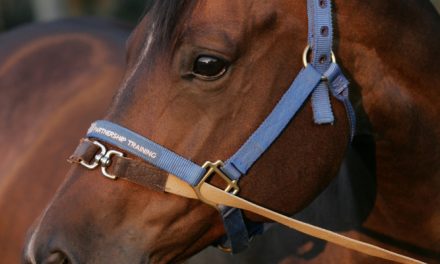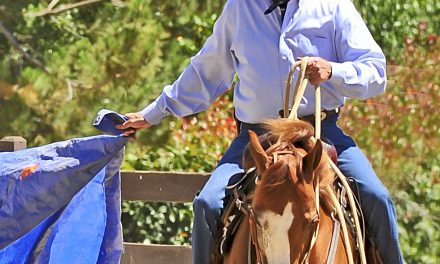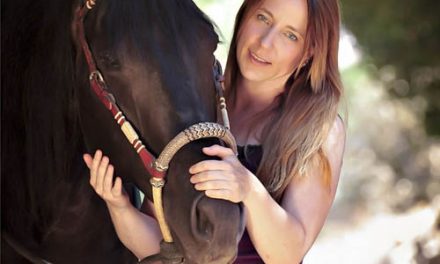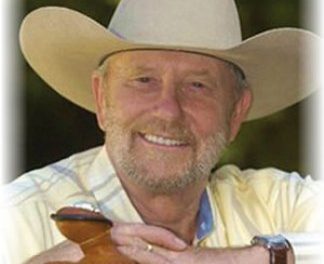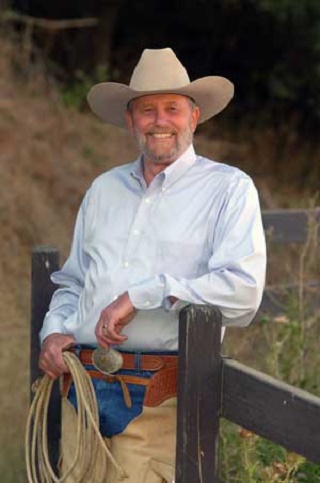
Many of us ride trails that cross creeks that may be dry in summer and fill with winter rains. Also, you never know when you will encounter a dead fall that blocks a trail. If your horse balks at a creek or any other obstacle, you need to get him comfortable with crossing.
To teach a horse to go over obstacles the horse must already understand certain things and we must have control of the horse. You must be able to control your horse’s nose, shoulders and hind quarters. The horse must know how to lunge on a 12 or 14-foot line and give to pressure. You need to have established a strong go-forward cue with your horse and be able to stop his feet and change direction.
To begin this lesson, we start with ground work. A simple object like a pole is placed on the ground. A pole is not usually a threatening object although some horses can have issues with even these benign objects. Cue the horse forward on the line, then stop his feet and change directions. When the horse is moving calmly, put the pole down about ten feet away. Begin to work the horse on the lunge line several feet away from the pole and as you move the horse around, he will pass between you and the pole. Stop the horse at the furthest point from the pole and pause. Let the horse look at the pole and then send the horse the other way around.
Once you have the horse comfortably passing between you and the pole, ask it to take a step over the object. When you ask, you have to step toward the pole moving the shoulder away from you with just enough pressure that the horse will move toward the pole. The horse can choose to go over the pole or between you and the pole but do not let him go around it. You may want to do this exercise near an arena wall or fence to keep the horse from going around the outside of the pole. You do not want the horse to pull you but you must block the horse from going around the pole.
The second criterion is that the horse must not be allowed to stop and change direction away from the pole. If the horse is concerned about the pole, you need to change the horse’s reaction. Most horses that do not want to go over an object will try to stop, backup or bolt in a different direction. In this exercise, the horse is allowed to go over the pole or between you and the pole. The horse is not allowed to stop and reverse direction. If the horse does this, you must stop the horse immediately with whatever amount of pressure is necessary and send him back forward again. It is all right if you have to step back away from the pole to open a door for the horse to go between you and the pole. You do not want to lose the forward motion.
Once you have done this several times you’ll find the horse is more willing to go over the pole. At first, the horse may rush or jump the pole. Once the horse is comfortable going over the pole at a walk, you can add a second pole. When the horse is comfortable with this you can roll out a tarp, 8 feet long and folded to 12 inches wide. Lay it on the poles so that it does not move and ask the horse to go over it. Again, when the horse is comfortable, open the tarp to 24 inches wide. Once the horse will go willingly over the tarp, keep opening the tarp wider. The length of the tarp is also important because you don’t want to make it easy for the horse to go around.
Once you have mastered this exercise on the ground, move to the saddle. Do the same thing going forward with good control of the hips. If the horse jumps the object and trots off, you must be able to pick up the inside rein, block with the outside rein and move the hips over. If the horse goes off at a canter or lope, depending on your disciple, you need to circle the horse down to a trot and then move the hips over. Moving the hips over breaks the speed and is a way of discouraging the horse from bolting. Once the horse is under control, take him back across the object. Continuing to do this begins to build the horse’s confidence. Eventually the tarp can be 12 feet long and 8 feet wide and the horse will be comfortable crossing it.
When you are on the trail and come to an obstacle, it is important to remember that a horse can go in six different directions, right, left, up, down, forward and back. If the horse backs up, drive him forward. You can use spurs or a stick and drive it forward but if the horse is very apprehensive, wait until the horse has stopped backing. Keep the nose directed at the object; do not allow the horse to turn around. Keep the nose straight and the moment the horse stops backing, ask him to go forward. An established go-forward cue is important here. If your horse jumps a creek, once he is over, let him continue for 10 or 15 feet. Pick up one rein, turn him around and move a hip over. Pause and send him back over the creek. If he jumps again, repeat the process until he walks through it. Then you can pick up one rein, move his shoulder or hip over and ask him to stand in the creek. If your horse exhibits anxiety, don’t force him to stay there. Let him out and then take him back through it again. Go back and forth until he no longer cares.
If you ask the horse to go straight and he goes to the right or left, his nose may be straight but his shoulder is bleeding out. You need to work on shoulder control. If the horse wants to go sideways and you don’t have control of the shoulders, you will not be successful crossing an obstacle. It comes down to having a solid go-forward cue and good control of the shoulders. You need to practice this before you get in the saddle. If you have that, you can teach your horse to go over most objects that you may encounter on the trail. This exercise is discussed in detail in both of my books, Starting Baby Jaz and Building Your Dream Horse. I also describe these exercises in Ground Manners and Leading, a DVD that is currently available.

